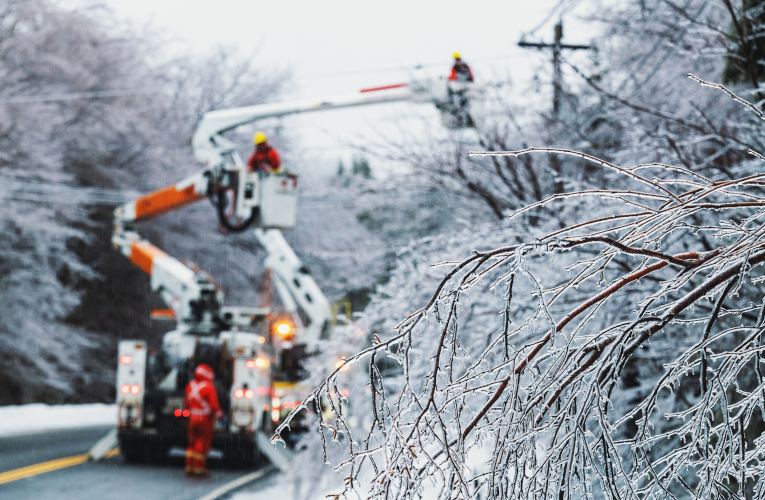
Industry Insights
The Critical Role of AI and ML in Enhancing Utility Safety This Winter
As temperatures drop and winter sets in, safety becomes a heightened priority for utilities and their customers. Extreme winter weather events—such as snowstorms, ice accumulation and freezing conditions—pose risks not only to grid infrastructure but also to the communities relying on reliable energy and water. Weather-related outages have almost doubled over the last decade in the United States, with winter storms accounting for nearly one-quarter of these outages.
Fortunately, advancements in artificial intelligence (AI) and machine learning (ML) are transforming how utilities protect customers, crews and critical infrastructure during the harsh winter months.
Insights from our 2024 Resourcefulness Insight Report, Exploring AI for Utilities: The Promise and Challenges of Artificial Intelligence, reveal that 43% of utility executives cite detecting and managing potentially dangerous situations as AI and ML’s most impactful use case. With 82% of utilities saying they are actively adopting AI/ML technologies—and nearly half (49%) already leveraging them for safety—customers are benefiting from their utility’s measurable progress in risk detection, response and resilience.
Here are a few ways that utilities can leverage AI and ML to enhance safety during the winter season.
Real-Time Detection of Hazardous Conditions
The foundation of any AI-driven solution is high-quality, actionable data—and utilities are increasingly turning to grid edge intelligence technologies to provide it. IoT sensors, smart meters and distributed intelligence endpoints collect and prioritize the transmission of critical data on grid performance, environmental conditions and energy loads.
During the winter months, this real-time visibility becomes invaluable. For instance:
- Detecting Impedance Issues: AI models can identify trends of increasing impedance or abnormal voltage fluctuations, which are often early signs of failing transformers or overloaded circuits. By acting on this data, utilities can address equipment risks before they escalate into safety hazards or long outages.
- Monitoring Extreme Conditions: IoT sensors capture environmental data like ice accumulation, freezing temperatures and pole tilt. These inputs feed AI systems that predict where infrastructure may be most vulnerable, enabling preemptive maintenance.
- Automating Local Decisions: Advanced grid edge intelligence allows devices to make split-second decisions locally. Turning down or curtailing non-essential loads due to local peaks, for example, can autonomously reduce overloaded lines and protect essential services such as space heating and safety systems.
By identifying issues early, AI minimizes risks to both infrastructure and public safety while improving the speed of response.
Predictive Maintenance Prevents Downtime
Winter weather strains aging infrastructure, and reactive maintenance isn’t enough to keep systems safe. Utilities can leverage AI to:
- Prioritize Repairs: By analyzing historical outage data and real-time grid conditions, AI can learn from and identify the most at-risk assets, such as transformers nearing capacity or lines susceptible to excess sag from the added weight of ice and snow.
- Optimize Crews and Resources: Predictive analytics help utilities pre-position repair crews and materials ahead of winter storms, reducing response times and minimizing outages.
- Extend Asset Life: AI-powered insights allow utilities to perform targeted, condition-based maintenance, extending the lifespan of critical infrastructure and reducing costly emergency repairs.
Currently, 33% of utilities surveyed already utilize AI/ML for predictive maintenance, highlighting its growing role in keeping grids operational.
Enhancing Resilience Through Automated Response
When winter storms strike, utilities must act quickly to restore services. New technologies, such as AI, enable faster, more informed decisions during incident response by automating processes that traditionally relied on manual intervention. For example:
- Remote Disconnects: Advanced metering infrastructure (AMI) allows utilities to safely disconnect or reconnect services remotely in hazardous conditions, such as flooded or frozen neighborhoods.
- Resource Allocation: AI-driven models optimize the deployment of repair crews, equipment and materials to the hardest-hit areas. By combining weather forecasts with real-time grid data, utilities can efficiently prioritize resources for maximum impact.
- Resilience Simulations: AI simulates restoration scenarios to determine the fastest, safest way to restore power to critical infrastructure like hospitals, warming (or cooling) shelters and water treatment plants.
With 31% of surveyed utilities already using AI for grid resiliency and outage management, these capabilities are becoming indispensable for improving incident response.
Data-Driven Insights for Long-Term Safety Strategies
AI doesn’t just help during emergencies—it provides utilities with actionable insights to enhance safety year-round. By analyzing trends from historical outage data, weather patterns and grid performance, AI can guide investments in infrastructure hardening, such as upgrading aging equipment or updating reserve requirements in more susceptible areas.
These data-driven decisions ensure utilities are better prepared for future winters while reducing the likelihood of recurring issues.
Transforming Winter Preparedness with AI and ML
While the dangers of winter storms are well-known, the National Renewable Energy Laboratory reports that utilities are experiencing new impacts due to changing storm characteristics. For example, in regions like the Midwest and the Northeast, warmer average winter temperatures have caused previously dry areas to experience icing on conductors, heightening the risk to grid infrastructure.
As utilities navigate winter’s challenges, AI / ML can provide a path to greater safety, efficiency and resilience. By harnessing the power of real-time data, predictive analytics and grid edge intelligence, utilities can keep their systems safe, reliable and adaptive in an ever-changing environment.
To explore more about the future of AI in utilities and its implications, download a copy of Itron's 2024 Resourcefulness Insight Report and/or the actual research at itron.com/resourcefulness.
Related Articles
HTML Example
A paragraph is a self-contained unit of a discourse in writing dealing with a particular point or idea. Paragraphs are usually an expected part of formal writing, used to organize longer prose.








